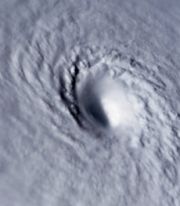Terrence Aym Salem-News.com

Superstorms can also cause certain societies, cultures or whole countries to collapse. Others may go to war with each other.
 Courtesy: Weather Snob |
(CHICAGO) - NASA has been warning about it…scientific papers have been written about it…geologists have seen its traces in rock strata and ice core samples…

Now "it" is here: an unstoppable magnetic pole shift that has sped up and is causing life-threatening havoc with the world's weather.
Forget about global warming—man-made or natural—what drives planetary weather patterns is the climate and what drives the climate is the sun's magnetosphere and its electromagnetic interaction with a planet's own magnetic field.
When the field shifts, when it fluctuates, when it goes into flux and begins to become unstable anything can happen. And what normally happens is that all hell breaks loose.
Magnetic polar shifts have occurred many times in Earth's history. It's happening again now to every planet in the solar system including Earth.
The magnetic field drives weather to a significant degree and when that field starts migrating superstorms start erupting.
The superstorms have arrived
The first evidence we have that the dangerous superstorm cycle has started is the devastating series of storms that pounded the UK during late 2010.
 |
On the heels of the lashing the British Isles sustained, monster storms began to lash North America. The latest superstorm — as of this writing — is a monster over the U.S. that stretched across 2,000 miles affecting more than 150 million people.
Yet even as that storm wreaked havoc across the Western, Southern, Midwestern and Northeastern states, another superstorm broke out in the Pacific and closed in on Australia.
The southern continent had already dealt with the disaster of historic superstorm flooding from rains that dropped as much as several feet in a matter of hours. Tens of thousands of homes were damaged or destroyed. After the deluge tiger sharks were spotted swimming between houses in what was once a quiet suburban neighborhood.
Shocked authorities now numbly concede that much of the water may never dissipate and have wearily resigned themselves to the possibility that region will now contain a new inland sea.
But then only a handful of weeks later another superstorm; the megamonster cyclone Yasi, struck northeastern Australia. The damage it left in its wake is being called by rescue workers a war zone.
The incredible superstorm packed winds near 190mph. Although labeled as a category-5 cyclone, it was theoretically a category-6. The reason for that is storms with winds of 155mph are considered category-5, yet Yasi was almost 22 percent stronger than that.



